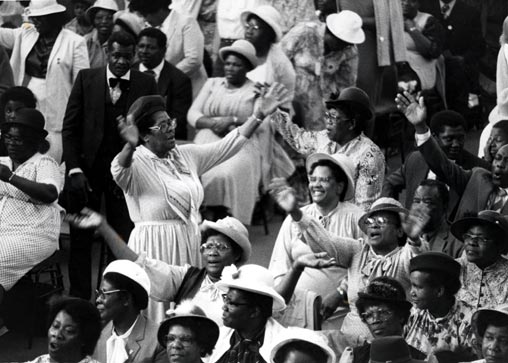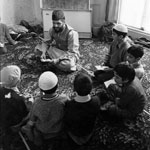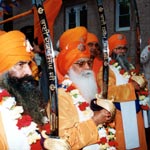
Introduction
Encountering a New Religious Landscape
Establishing Places of Worship
Supporting the Community
Directions for Further Learning
Introduction
Religion was a crucial aspect of the heritage and cultural practice that migrants brought with them to Britain. As they settled, their lives were infused with religion: celebrations, dress, food, relationships, architecture, education and charity often had their basis in religious tradition. Religion was an important source of spiritual and social support to people in diasporic communities who were uprooted from a familiar world into one that was strange and unknown. Gathering with fellow worshippers on a regular basis could give people the sense of belonging to a family when their families might have been very distant from them back in their countries of origin. The institutions that developed enabled traditional practices to continue yet the change of environment also served to challenge them. Through rituals, celebrations and architecture religion provided migrants with the spiritual strength, group identity and visible presence to overcome both isolation and alienation. It was also to transform the social and spiritual landscape of Birmingham forever.
<return to top>
Encountering a New Religious Landscape
Coming from cultures in which the practice of religion was deeply embedded, many migrants were unprepared for the different religious landscape they were to find in Britain. Pre-war Birmingham had made a small number of provisions for religious groups other than Christians: the synagogues of the older Jewish community, two mosques and a Muslim burial ground existed in the city before the end of the war. As greater numbers of migrants arrived, more structures had to be created to cater for their spiritual needs.
Although Britain was officially a Christian country Caribbean migrants, many of whom were members of Christian traditions on the islands, encountered a religious landscape that was strange to them. Not only were the atmosphere and style of worship in churches different but many were surprised and disappointed at the low levels of attendance in England. Lester Burke, who grew up in a devout family in St Philip's Barbados, found the traditional image of English church life held by Barbadians completely shattered when he attended St Xavier's Church in Saltley on Christmas Day 1960. Used to crowded congregations, the sight of only two other people in the church upset him:
"I went home to my uncle and he says, “What’s the matter with you?” I said, “Uncle but there’s nobody in church” he says, “I could have told you that, but you had to see for yourself.” I didn’t want Christmas dinner, I was so disappointed because I thought well in England, above all places, here in a country where everything is supposed to be this way and Barbados was just full of tradition upon the English way of life and here one of the cornerstones of it. It was awful. He said to me, “I’ll show you where the people are”. They weren’t in church, they were in a pub. Well to me I didn’t know what a pub was at all and he said, “I’ll show you one day what a pub is all about, that made me want to go home, want to go back to Barbados…" [MS 2255/2/076 p3]
Despite their enthusiasm for church attendance, black Christian migrants were to be disappointed again when they found that they were not welcome in many churches due to racial prejudice. In the same way as some landlords refused to accept black tenants, some vicars made excuses to turn black worshippers from their doors:
"On my first Sunday in Birmingham my friends and I, we put on our best suits and went to the church. But after the service the vicar told us not to come again. His congregation wouldn't like it, he said." (Birmingham ILT Services 1987:71)
As a result of racial discrimination in English churches and the social, cultural and theological distinctiveness of Black Christianity, Caribbean migrants were excluded from fully participating in many churches. Thus in a similar way to the Sikhs, Muslims and Hindus from South Asia who found little or no provision for their religious needs when they arrived, Christians from the Caribbean islands set about establishing spaces for themselves to cater for the spiritual needs of their community.
<return to top>
Establishing Places of Worship
Early places of worship were often set up by migrants wherever they could find space to worship together. Muslims often congregated in dwelling houses for the Friday communal prayer: in the early 1940's houses in Edward Road in Balsall Heath and Speedwell Road in Edgbaston had been registered as mosques for the Yemeni and Indian communities respectively (A History of the County of Warwickshire, 1964). Likewise, the Bangladeshi Masjid-e-Noor began life in the 1960s as a house in Aston (Millennibrum Supplement, 27 December 2000).
Many of the early black churches began in the same way: in 1964 a Seventh Day Adventist church group was started in the front room of 15 Holly Road in Handsworth before moving to a room in St John's school hall and then to a room in the nearby church in Sparkhill. Other early black churches which were first accommodated in schoolrooms in Birmingham during the 1950s and 60s included:
- African Methodist Episcopalian Zion Church at Westminster Road School, Handsworth
- Church of the Cherubim and Seraphim at Benson Road School, Winson Green
- United Church of God, Rookery Road School, Handsworth
- Anglo West Indian Assembly, Frederick Road School, Aston
- Pentecostal Assemblies of the World, Westminster Road School, Handsworth
- Pentecostal Church of God, City Road School, Edgbaston
- Triumphant Church of God, Heathfield Road School, Lozells
Black congregations brought a distinctive approach to worship. Many Pentecostal church services were spontaneous, and worshippers participated in the proceedings with enthusiasm, dressing in their finest clothes, playing tambourines and testifying with ecstatic praise. You may view images associated with Birmingham's black churches in the 'Church and Community' exhibition in City Stories.
As the size of congregations increased it became necessary for members of all faiths to search for larger and more permanent spaces. With the advent of South Asian migrants during the 1950s and 60s which boosted Birmingham's Muslim population, there was a need to accommodate greater numbers of worshippers especially on Eid. A mosque project, which relied on donations from the Muslim and non-Muslim community, was organised and created the second purpose-built mosque in Britain - Birmingham Central Mosque in Belgrave Middleway. A newsletter produced by the Sparkbrook Association refers to collections being made by its Pakistan Liaison Officer Major Murtaza Jan for the religious, cultural and social centre for Muslims which would act as "a bridge of understanding between the different communities, their culture and religion, in the true tradition of Islam" [MS 1914/1/8/1].
As well as purpose-built premises, the conversion of buildings such as warehouses, cinemas and schools into places of worship demonstrate the transformation of the city's physical landscape into a diverse spiritual space as migrants settled. The Shree Ram Mandir on Walford Road in Sparkbrook which took over the site of the Walford Road Picture House is such an example. Similarly, the Guru Nanak Gurdwara in Smethwick which was established in 1961 at 130 High Street (the site of a former church) symbolises the continuity and diversity of religious observance in Birmingham and its environs.
<return to top>
Supporting the Community
Religious institutions offered migrants far more than a religious experience, playing a key role in the settlement process. Many churches, mosques, gurdwaras and temples housed supplementary schools, welfare services and provided a meeting place where migrants could reaffirm their religious and cultural identity. Pentecostal churches, which were significant among the black churches in Birmingham, often provided home visits, lunch clubs, advocacy and mediation services and social contact for older isolated members (Small, 1994). Roswith Gerloff, who conducted a study of black Christian communities in Birmingham during the 1970's found that black churches helped to overcome alienation, preserved black dignity and developed strong leadership which had the potential to transform society (Gerloff, 1975:66).
Charities were also an important part of the support offered within religious communities but also extended to the diaspora and communities throughout the world. The Birmingham based Islamic Relief, which was formed in 1984 by an Egyptian doctor in response to the African famine, was one such charity which focused on a wider concept of community. Flyers for the Muslim charity's fund-raising events can be found amongst the ephemera of the Vanley Burke archive [MS 2192/C/D/2/5].
<return to top>
Directions for Further Learning
Birmingham is, and has been, host to a considerable number of inter-faith activities which have involved the development of organisations such as Birmingham Council of Faiths, the Centre for the Study of Islam and Christian-Muslim Relations and Birmingham Faith Leaders Group. An area for further research might be to explore the history of such groups and their activity in the city.
Rites of passage in religious traditions are significant events in the lives of individuals and communities. In bringing people together they have been an important part of consolidating migrant community life. Several collections in Birmingham City Archives such as the Vanley Burke collection [MS 2192] and the records of Singers Hill Synagogue [JA/2] contain material such as orders of service and booklets which commemorate important life stages such as births, marriages, bar mitzvahs and death. You may wish to look at this material which provides an insight into the role of religion in different communities.
<return to top>
Author: Sarah Dar
Main Image: Photograph by Vanley Burke [City Archives: MS 2192]
<return to top>
|
|

Muslim Supplementary Schools

Vaisakhi Celebrations
|